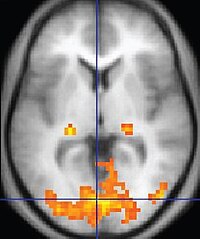
Photo from wikipedia
Task-based functional Magnetic Resonance Imaging (fMRI) has been widely used to determine population-based brain activations for cognitive tasks. Popular group-level analysis in fMRI is based on the general linear model… Click to show full abstract
Task-based functional Magnetic Resonance Imaging (fMRI) has been widely used to determine population-based brain activations for cognitive tasks. Popular group-level analysis in fMRI is based on the general linear model and constitutes a univariate method. However, univariate methods are known to suffer from low sensitivity for a given specificity because the spatial covariance structure at each voxel is not taken entirely into account. In this study, a spatially constrained local multivariate model is introduced for group-level analysis to improve sensitivity at a given specificity for activation detection. The proposed model is formulated in terms of a multivariate constrained optimization problem based on the maximum log likelihood method and solved efficiently with numerical optimization techniques. Both simulated data mimicking real fMRI time series at multiple noise fractions and real fMRI episodic memory data have been used to evaluate the performance of the proposed method. For simulated data, the area under the receiver operating characteristic curves in detecting group activations increases for the subject and group level multivariate method by 20%, as compared to the univariate method. Results from real fMRI data indicate a significant increase in group-level activation detection, particularly in hippocampus, para-hippocampal area and nearby medial temporal lobe regions with the proposed method.
Journal Title: NeuroImage
Year Published: 2019
Link to full text (if available)
Share on Social Media: Sign Up to like & get
recommendations!